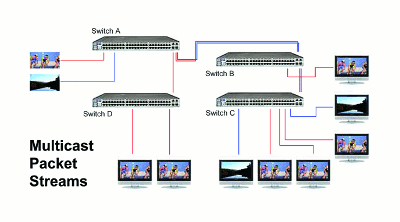Case Study: Sony Music Turns to IPTV for Business TV
Leveraging Multicast Protocols
The multicast protocols are key to reducing the bandwidth overhead of adding video to the IT network. IGMP establishes membership groups for every IPTV channel and assigns a user request to join a particular group to the nearest switch. Each stream is placed on the network just once and is replicated as necessary by the network switches at the last possible switch in the path to the end user, minimising data overhead. This mechanism distributes multicast traffic from the video source to many multicast clients. If necessary, PIM is also used, between IT network routers, to direct multicast streams from one LAN segment to another.
"Installation is straightforward and inexpensive, and the beauty of it is that it can use a company's existing infrastructure," Rackowe says. "There are some decisions the IT team needs to consider. They first of all need to ensure that all switches are Layer 3 and will support IGMP. Then they need to ask if there's a need for the IPTV streams to cross VLANs or subnets; perhaps connecting multiple sites or serving desktops on a corporate VLAN as well as displays or digital signage on a different VLAN. In most cases, the answer is yes, so you need to make sure that the network routers support PIM Sparse (PIM-SM), the most commonly used multicast routing protocol."
 For most companies, a restricted connectivity with the external internet means high-resolution video from the internet is out
For most companies, a restricted connectivity with the external internet means high-resolution video from the internet is out
of the question. IPTV systems can deliver digital picture quality to the desktop immune from noise, distortion, and signal loss; unlimited channels with controlled user access; and remote system management by way of a web browser interface. HD is fully supported, and computer outputs can be distributed as high-definition IPTV channels using IPTV encoding.
"The trend toward business IPTV is increasing," Rackowe says. "As the awareness level grows, it has become the standard. I'd be surprised to see any new building where there's a need for some level of TV distribution being dealt with by putting in a system other than IPTV."